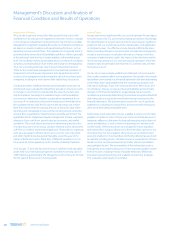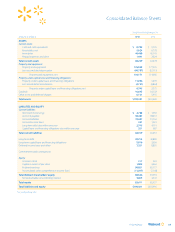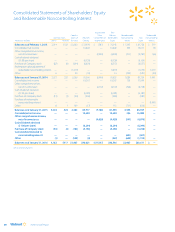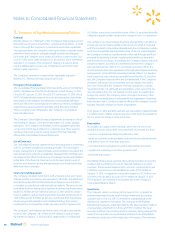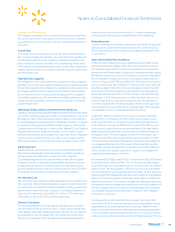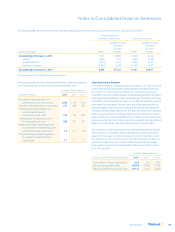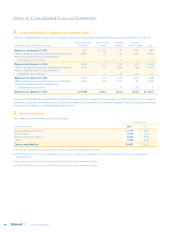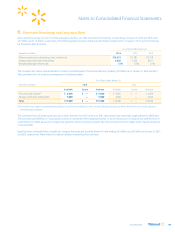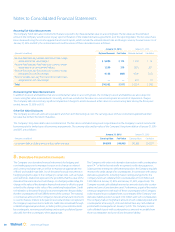Walmart 2016 Annual Report Download - page 43
Download and view the complete annual report
Please find page 43 of the 2016 Walmart annual report below. You can navigate through the pages in the report by either clicking on the pages listed below, or by using the keyword search tool below to find specific information within the annual report.
41Only Walmart
at the Sam’s Club segment is valued based on the weighted-average
cost using the LIFO method. At January 31, 2016 and January 31, 2015,
the Company’s inventories valued at LIFO approximated those inventories
as if they were valued at FIFO.
Property and Equipment
Property and equipment are stated at cost. Gains or losses on disposition
are recognized as earned or incurred. Costs of major improvements are
capitalized, while costs of normal repairs and maintenance are charged
to expense as incurred. The following table summarizes the Company’s
property and equipment balances and includes the estimated useful lives
that are generally used to depreciate the assets on a straight-line basis:
Fiscal Years Ended
Estimated January 31,
(Amounts in millions) Useful Lives 2016 2015
Land N/A $ 25,624 $ 26,261
Buildings and improvements 3-40 years 96,845 97,496
Fixtures and equipment 1-30 years 47,033 45,044
Transportation equipment 3-15 years 2,917 2,807
Construction in progress N/A 4,539 5,787
Property and equipment $176,958 $177,395
Accumulated depreciation (66,787) (63,115)
Property and equipment, net $110,171 $114,280
Leasehold improvements are depreciated or amortized over the shorter
of the estimated useful life of the asset or the remaining expected lease
term. Total depreciation and amortization expense for property and
equipment, property under financing obligations and property under
capital leases for fiscal 2016, 2015 and 2014 was $9.4 billion, $9.1 billion
and $8.8 billion, respectively. Interest costs capitalized on construction
projects were $39 million, $59 million and $78 million in fiscal 2016, 2015
and 2014, respectively.
Leases
The Company estimates the expected term of a lease by assuming the
exercise of renewal options where an economic penalty exists that
would preclude the abandonment of the lease at the end of the initial
non-cancelable term and the exercise of such renewal is at the sole
discretion of the Company. The expected term is used in the determination
of whether a store or club lease is a capital or operating lease and in the
calculation of straight-line rent expense. Additionally, the useful life of
leasehold improvements is limited by the expected lease term or the
economic life of the asset, whichever is shorter. If significant expenditures
are made for leasehold improvements late in the expected term of a
lease and renewal is reasonably assured, the useful life of the leasehold
improvement is limited to the end of the renewal period or economic
life of the asset, whichever is shorter. Rent abatements and escalations
are considered in the calculation of minimum lease payments in the
Company’s capital lease tests and in determining straight-line rent
expense for operating leases.
The Company is often involved in the construction of its leased stores.
In certain cases, payments made for certain structural components
included in the lessor’s construction of the leased assets result in the
Company being deemed the owner of the leased assets for accounting
purposes. As a result, regardless of the significance of the payments,
Accounting Standards Codification 840, Leases, (“ASC 840”) defines those
payments as automatic indicators of ownership and requires the Company
to capitalize the lessor’s total project cost with a corresponding financing
obligation. Upon completion of the lessor’s project, the Company performs
a sale-leaseback analysis pursuant to ASC 840 to determine if these assets
and the related financing obligation can be derecognized from the
Company’s Consolidated Balance Sheets. If the Company is deemed to
have “continuing involvement,” the leased assets and the related financing
obligation remain on the Company’s Consolidated Balance Sheets and
are generally amortized over the lease term.
Long-Lived Assets
Long-lived assets are stated at cost. Management reviews long-lived assets
for indicators of impairment whenever events or changes in circumstances
indicate that the carrying amount may not be recoverable. The evaluation
is performed at the lowest level of identifiable cash flows, which is at the
individual store or club level or, in certain circumstances, a market group of
stores. Undiscounted cash flows expected to be generated by the related
assets are estimated over the assets’ useful lives based on updated projections.
If the evaluation indicates that the carrying amount of the assets may not
be recoverable, any potential impairment is measured based upon the fair
value of the related asset or asset group as determined by an appropriate
market appraisal or other valuation technique. Impairment charges of
long-lived assets for fiscal 2016, 2015 and 2014 were not material.
Goodwill and Other Acquired Intangible Assets
Goodwill represents the excess of the purchase price over the fair value
of net assets acquired in business combinations and is allocated to the
appropriate reporting unit when acquired. Other acquired intangible
assets are stated at the fair value acquired as determined by a valuation
technique commensurate with the intended use of the related asset.
Goodwill and indefinite-lived intangible assets are not amortized; rather,
they are evaluated for impairment annually and whenever events or
changes in circumstances indicate that the value of the asset may be
impaired. Definite-lived intangible assets are considered long-lived
assets and are amortized on a straight-line basis over the periods that
expected economic benefits will be provided.
Goodwill is evaluated for impairment using either a qualitative or
quantitative approach for each of the Company’s reporting units. Generally,
a qualitative assessment is first performed to determine whether a
quantitative goodwill impairment test is necessary. If management
determines, after performing an assessment based on the qualitative
factors, that the fair value of the reporting unit is more likely than not
less than the carrying amount, or that a fair value of the reporting unit
substantially in excess of the carrying amount cannot be assured, then
a quantitative goodwill impairment test would be required. The quantitative
test for goodwill impairment is performed by determining the fair
value of the related reporting units. Fair value is measured based on the
discounted cash flow method and relative market-based approaches.
The Company’s reporting units were evaluated using a quantitative
impairment test. Management determined the fair value of each reporting
unit is greater than the carrying amount and, accordingly, the Company
has not recorded any impairment charges related to goodwill.
Notes to Consolidated Financial Statements



